Simple and efficient differentiation of human iPSCs into contractible skeletal muscles for muscular disease modeling
- PMID: 37231024
- PMCID: PMC10213064
- DOI: 10.1038/s41598-023-34445-9
Simple and efficient differentiation of human iPSCs into contractible skeletal muscles for muscular disease modeling
Abstract
Pathophysiological analysis and drug discovery targeting human diseases require disease models that suitably recapitulate patient pathology. Disease-specific human induced pluripotent stem cells (hiPSCs) differentiated into affected cell types can potentially recapitulate disease pathology more accurately than existing disease models. Such successful modeling of muscular diseases requires efficient differentiation of hiPSCs into skeletal muscles. hiPSCs transduced with doxycycline-inducible MYOD1 (MYOD1-hiPSCs) have been widely used; however, they require time- and labor-consuming clonal selection, and clonal variations must be overcome. Moreover, their functionality should be carefully examined. Here, we demonstrated that bulk MYOD1-hiPSCs established with puromycin selection rather than G418 selection showed rapid and highly efficient differentiation. Interestingly, bulk MYOD1-hiPSCs exhibited average differentiation properties of clonally established MYOD1-hiPSCs, suggesting that it is possible to minimize clonal variations. Moreover, disease-specific hiPSCs of spinal bulbar muscular atrophy (SBMA) could be efficiently differentiated via this method into skeletal muscle that showed disease phenotypes, suggesting the applicability of this method for disease analysis. Finally, three-dimensional muscle tissues were fabricated from bulk MYOD1-hiPSCs, which exhibited contractile force upon electrical stimulation, indicating their functionality. Thus, our bulk differentiation requires less time and labor than existing methods, efficiently generates contractible skeletal muscles, and may facilitate the generation of muscular disease models.
© 2023. The Author(s).
Conflict of interest statement
HO is a paid member of the Scientific Advisory Board of SanBio Co., Ltd., and YO is a scientific advisor of Kohjin Bio Co., Ltd. The other authors declare no competing financial interests.
Figures

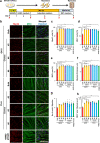
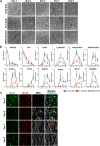

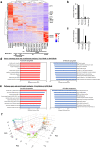
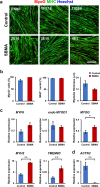
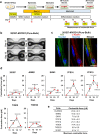
Similar articles
-
Efficient and reproducible myogenic differentiation from human iPS cells: prospects for modeling Miyoshi Myopathy in vitro.PLoS One. 2013 Apr 23;8(4):e61540. doi: 10.1371/journal.pone.0061540. Print 2013. PLoS One. 2013. PMID: 23626698 Free PMC article.
-
Optimized simple culture protocol for inducing mature myotubes from MYOD1-overexpressed human iPS cells.Sci Rep. 2024 Nov 20;14(1):28783. doi: 10.1038/s41598-024-79745-w. Sci Rep. 2024. PMID: 39567611 Free PMC article.
-
Directed Myogenic Differentiation of Human Induced Pluripotent Stem Cells.Methods Mol Biol. 2016;1353:89-99. doi: 10.1007/7651_2015_257. Methods Mol Biol. 2016. PMID: 25971915
-
Current Status and Challenges of Human Induced Pluripotent Stem Cell-Derived Liver Models in Drug Discovery.Cells. 2022 Jan 27;11(3):442. doi: 10.3390/cells11030442. Cells. 2022. PMID: 35159250 Free PMC article. Review.
-
Induced Pluripotent Stem Cells for Tissue-Engineered Skeletal Muscles.Int J Mol Sci. 2023 Jul 15;24(14):11520. doi: 10.3390/ijms241411520. Int J Mol Sci. 2023. PMID: 37511279 Free PMC article. Review.
Cited by
-
A repository of Ogden syndrome patient derived iPSC lines and isogenic pairs by X-chromosome screening and genome-editing.bioRxiv [Preprint]. 2024 Sep 28:2024.09.28.615067. doi: 10.1101/2024.09.28.615067. bioRxiv. 2024. PMID: 39386428 Free PMC article. Preprint.
-
Dynamic and Static Workout of In Vitro Skeletal Muscle Tissue through a Weight Training Device.Adv Healthc Mater. 2024 Dec;13(32):e2401844. doi: 10.1002/adhm.202401844. Epub 2024 Aug 30. Adv Healthc Mater. 2024. PMID: 39212188 Free PMC article.
-
A longevity-specific bank of induced pluripotent stem cells from centenarians and their offspring.Aging Cell. 2025 Jan;24(1):e14351. doi: 10.1111/acel.14351. Epub 2024 Sep 25. Aging Cell. 2025. PMID: 39319670 Free PMC article.
-
Enhancing human pluripotent stem cell differentiation to cardiomyocytes through cardiac progenitor reseeding and cryopreservation.iScience. 2025 Apr 16;28(5):112452. doi: 10.1016/j.isci.2025.112452. eCollection 2025 May 16. iScience. 2025. PMID: 40454098 Free PMC article.
-
Emerging Targets and Treatments for Sarcopenia: A Narrative Review.Nutrients. 2024 Sep 27;16(19):3271. doi: 10.3390/nu16193271. Nutrients. 2024. PMID: 39408239 Free PMC article. Review.
References
Publication types
MeSH terms
LinkOut - more resources
Full Text Sources
Medical
Molecular Biology Databases
Research Materials

